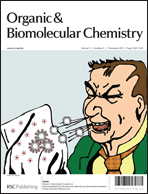
This HOT article describes a gold nanoparticle-based colorimetric assay for the detection of influenza. Specificity was achieved by targeting the haemagglutanin (HA) surface glycoprotein. Human influenza binds preferentially to sialic acid α2,6 galactose sequences and avian influenza preferentially binds to sialic acid α2,3 galactose sequences. Gold nanoparticles were functionalised with trivalent α2,6-thio-linked sialic acid ligands and polyethylene glycol ligands. A solution of gold nanoparticles was used to detect HA virus surface glycoproteins and in the presence of human influenza virus a colour change was observed. The colour change was caused by the aggregation of the glycopeptide with the influenza virus and was detectable with the naked eye. Owing to the careful choice of ligands, this assay was able to discriminate between human and avian H5N1 influenza.
Glyconanoparticles for the plasmonic detection and discrimination between human and avian influenza virus
María J. Marín, Abdul Rashid, Martin Rejzek, Shirley A. Fairhurst, Stephen A. Wharton, Stephen R. Martin, John W. McCauley, Thomas Wileman, Robert A. Field and David A. Russell
Org. Biomol. Chem., 2013,11, 7101-7107
DOI: 10.1039/C3OB41703D










